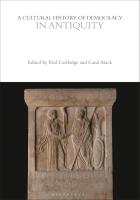
Bloomsbury Academic (2024) p/b 260pp £25 (ISBN 9781350439986)
It is important to set this volume (first published in hardback in 2021) in its context. Bloomsbury publish an extended series of ‘Cultural Histories’ covering topics as diverse as Dress, Fairy Tales, Hair, Law, Love and Peace. Each topic is covered in six chronological volumes—Antiquity, Mediaeval, Renaissance, Enlightenment, Age of Empire and Modern age. Each volume within a topic is in turn identically structured with chapters on the concepts key to the topic in hand: in this case, Sovereignty, Liberty and the Rule of Law, Common Good, Economics, Religion, Citizenship and Gender, Ethnicity and Nationalism, Crises and Revolutions, International relations, Beyond the Classical Polis. The idea is to provide the clearest opportunity for the reader to ‘compare and contrast’ how each topic developed during each historical period.
For this volume there are nine academic contributors to the individual chapters (including the editors), five from universities in the UK and four from North America. There are 47 black and white illustrations and nearly fifty pages of notes and references.
The contributors outline with admirable clarity and an absence of partisanship the multiple and contrasting ways in which the concept of democracy was both intellectualised and put into practice in antiquity. The accessibility of the text conceals the depth of scholarship which supports it. The contributors draw their examples mainly from the Greek polis and the Roman republic but include instances from the Hellenistic period (where democratic externals were on occasion used as a facade for hierarchical control). Inevitably, they frequently cite Aristotle, Cicero and Plato among their expert witnesses.
Those experts agreed that the entity to be governed (the polis) incorporated the entire community within its geographical boundaries. The aim of governance should be to achieve outcomes that most benefit that entire community (the koinê or res publica) rather than selected elements within the community. They also agreed that the best form of governance would be achieved by wise men acting altruistically. They distrusted democracy because they feared that the demos might act irrationally but accepted that, in the absence of the optimal, it was probably the least bad of the alternatives. They noted that oligarchies and autocracies often incorporated elements of democracy (say, juries and assemblies) into their constitutions.
To participate in a democracy the citizen had to be free (that is not a slave), male and in the Greek, but not the Roman, model a local inhabitant. A citizen had the right to be treated equally within the legal system (isonomia) and the right to express his views publicly (isêgoria). In any voting system each vote carried an equal weight. Citizens had a duty to participate in the administration of the constitution but might need financial help to do so.
Within the constitution, sovereignty was seen as the agency which could endorse the propriety of any major change to the constitution. Activists who ignored this endorsement were to be regarded as unauthorised tyrants. Religious activity (respect for the patron deity or themed festivals) provided vital cement to the constitution and was an area in which women were permitted to participate. Athenians also used the theatre to explore and question the philosophy and mechanics of governance. They were acutely aware that internal imbalances of power could lead to civil war—and indeed did so with appalling effect during the final years of the Roman Republic.
In theory this concept of democracy could be carried into a wider international context—the Athenians tried with the Delian League—but in practice the idea did not achieve much traction in antiquity.
As this is the only volume in this series which will naturally fall to Classics for All to review, this reviewer has also read the sixth ‘Modern Age’ volume to see how the early experts stack up against their modern counterparts. He was encouraged to note that they had asked almost all the questions which are still considered pertinent—by modern standards they had blind spots on inclusivity (gender, slavery and race) and on the welfare state; and they quite lightly explored sovereignty (especially in an international context). Otherwise, they analysed the topic very effectively and came to most of the conclusions that have since been reached while recognising that then, as now, there is a disconnect between the tidy theory and the messy reality.
This volume, and indeed the full series, is heartily recommended to the ordinary Classics for All reader, especially in these days when democracy and the rule of law seem in some quarters to be at risk of losing their way.
Roger Barnes
